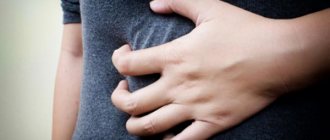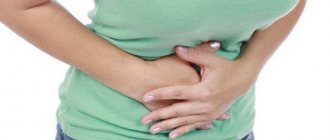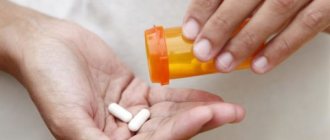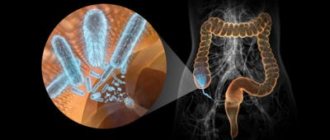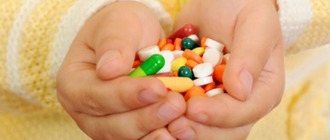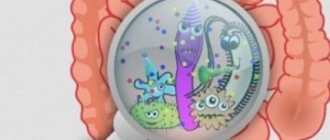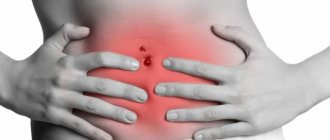After antibiotics, it is important to restore your body. And how to do this - you will find out in the article.
Today, there are a huge number of ailments that can only be effectively treated with antibiotics. The advantage of antibiotics is that they are able to quickly and effectively eliminate various ailments, including those that can be fatal. However, it is worth saying that such drugs also have their drawbacks. For example, antibiotics negatively affect the mucous membranes of our body, immunity, and disrupt the functioning of some internal organs.
It is because of the above-mentioned disadvantages of antibiotics that after taking them the body needs to be restored.
Symptoms of dysbiosis
The development of symptoms of dysbiosis in the initial stages can be blurred and atypical. The following signs of a pathological phenomenon begin to appear:
- deviations in digestion, resulting in heartburn, belching, nausea;
- pain in the upper abdomen;
- stool – most often of normal consistency, but with the presence of particles of undigested food;
- dry skin, rashes in the form of atopic dermatitis;
- fragility and splitting of nails, poor growth and dullness of hair due to the development of vitamin deficiency;
- due to decreased immunity, frequent viral infections;
- weight loss;
- deterioration of the general condition of the body.
Since these symptoms of dysbacteriosis are not specific, they are often missed by patients. Only when a detailed picture of dysbiosis begins to appear in the form of stomach pain and intestinal disorders do patients consult a doctor.
The effect of antibiotics on the human body
Due to the destruction of beneficial microflora, a disruption in the functioning of the digestive system occurs. Along with pathogenic organisms, bifidobacteria and lactobacilli are destroyed. Why is it the gastrointestinal tract system that suffers first? To digest substances entering the body, the glands of the stomach produce juice, consisting mainly of enzymes and hydrochloric acid. They help break down proteins and fats, as well as grind food into porridge. This makes it easier for it to get into the intestines, where some of the substances are absorbed and others are excreted. The same thing happens after antibiotics enter the body. Therefore, it is important to ask the question of protecting the gastrointestinal tract even before starting to take the drug.
Factors contributing to the development of dysbiosis
Stomach dysbiosis can develop not only as an independent disease, but also as a pathology that appears against the background of an existing disease of the digestive system. The following factors contribute to this phenomenon:
- stressful conditions;
- chronic diseases of internal organs;
- long-term use of antibiotics;
- errors in nutrition;
- abuse of alcohol, tonics and colored carbonated drinks;
- various gastrointestinal diseases;
- low body resistance.
Important! Stomach pain that appears after undergoing a course of antibiotic treatment for any disease in the form of exacerbation of a chronic pathology or acute infection requires mandatory examination and treatment by a gastroenterologist.
Before prescribing treatment, a diagnostic examination of the stomach is carried out to determine the presence of a disease against which dysbacteriosis develops. Diagnosis of the disease consists of the patient’s complaints, the clinical picture of the pathological condition, gastroscopy of the stomach, and laboratory tests.
After clarification of the diagnosis, therapeutic measures are prescribed. First of all, this is a diet, since a weakened stomach requires careful treatment to restore the normal digestion process.
Bifidumbacterin to stimulate healthy gastrointestinal flora
The drug Bifidumbacterin in tablet form
The medicine is produced in the form of tablets. The main active components of Bifidumbacterin are lactose and the biological mass of bifidobacteria. Unlike other prebiotics, this one cannot be used at any stage of pregnancy and during breastfeeding.
To achieve the required therapeutic effect, it is recommended to take 2 tablets up to 3 times a day. The duration of therapy is determined by the condition of the patient's gastrointestinal tract and can last up to 12 weeks. In some patients, the drug provoked undesirable reactions on the skin in the form of a rash, severe itching and the appearance of red spots. Side effects usually appeared in the first week of treatment.
Diet for stomach dysbiosis
Treatment of this pathology consists of a number of measures aimed at eliminating the causes that caused disruption of the microflora in the stomach. Treatment of the primary disease, against which dysbacteriosis has developed after taking a course of antibiotics, should be mandatory. Problems that arise in the functioning of the digestive system of the body require mandatory adherence to a diet in the diet.
In case of gastric dysbiosis, it is necessary to:
- consumption of fermented milk products enriched with live bifidobacteria;
- food processing is carried out only by steaming or stewing;
- It is preferable to consume soups, in the form of purees with grated vegetables, slimy porridges cooked in water;
- dishes from chopped dietary meat of chicken, turkey, rabbit;
- compotes, jelly, fruit drinks from fresh or dried fruits.
You should give up bad habits, such as:
- drinking alcohol;
- smoking;
- consumption of fatty beef, pork, lamb, fatty fish;
- dry food;
- consumption of confectionery products;
- eggs, hard-boiled and fried;
- white fresh bread.
Treatment of gastric dysbiosis can be long-term, including both medication, restorative therapy, and traditional medicine.
Prevention
You can minimize the harmful effects of antibiotics on the gastric mucosa and microflora by following these rules:
- Never take antibiotics without a doctor's prescription, for example, for acute viral infections.
- Strictly follow the instructions for using the medicine: before or after meals, dose, frequency of administration.
- During antibiotic therapy, adhere to a diet containing substances that protect the walls of the stomach (mucous porridges, jelly, puree soups).
- If the patient has already had manifestations of dysbiosis in the past when taking antibiotics orally, switch to parenteral (intramuscular or intravenous) administration. In this case, the medicine will enter the bloodstream, bypassing the gastrointestinal tract.
- Take the tablets only with cool boiled water. The components of tea, compote, milk react with the active ingredient of the medication.
- During treatment it is unacceptable to drink alcohol.
Drug treatment
Treatment with drugs is aimed at restoring the normal microflora of the stomach and relieving the symptoms of the pathological condition. In this case, several types of medicines are used:
- Prebiotics – Duphalac, Lactusan, Lactofiltrum. These drugs suppress the development of pathogenic flora in the stomach and stimulate the development of beneficial microorganisms. They have a strengthening effect on the immune system and help remove toxins from the body.
- Probiotics – Lactobacterin, Bifidumbacterin, Bifiform, Linex. These drugs contain living organisms that can fight pathogenic microflora of the stomach, suppressing their growth and reproduction.
- Antiseptics – Enterofuril, Intetrix. These are drugs that cause the death of pathogenic flora of the stomach and intestines.
- Bacteriophages – Intesti – bacteriophage, streptococcal bacteriophage. These are live viruses that have the ability to destroy certain types of staphylococci, salmonella, and enterococci.
Drug treatment of gastric dysbiosis should be prescribed only by a gastroenterologist. Self-medication can lead to neglect of the disease and difficulty in normalizing the functioning of the body’s digestive system.
How else to treat disorders of the digestive function of the stomach? In addition to medications, natural products rich in substances that can fight pathogenic flora in the stomach, suppressing their growth and reproduction, are used to treat dysbiosis:
- natural prebiotics – fermented milk products, chicory root, wheat bran, dried dried apricots and prunes, black and red currants, oranges, lemons, apples;
- natural probiotics – white and brown flax seeds, grapes, sauerkraut, corn grains, low-fat cottage cheese;
- natural antiseptics - onions, garlic, ginger root, seeds and fresh herbs of dill, fennel, nuts.
The use of natural products is possible in combination with recipes of traditional medicine, which offers a sufficient number of various decoctions and herbal infusions in the treatment of gastric dysbiosis.
Bifiform for healthy gastrointestinal microflora
Bifiform stimulates and regulates the natural functions of intestinal microflora
Available in the form of capsules for oral administration. After using antibiotics, it is prescribed to those patients who have developed dysbiosis due to the large number of pathogenic organisms in the microflora. The main active components of the drug are lactic acid bacteria. They are able to stimulate and regulate the natural functions of intestinal microflora. Additionally, stool normalizes and symptoms of intoxication disappear.
The dosage of Bifiform is 2-3 capsules per day, they should be taken before or with meals. In case of severe disorders, the daily amount of the active substance can be increased to 4 doses. To fully restore the functionality of the gastrointestinal tract, it is recommended to take Bifiform for 2-3 weeks.
Attention! The drug should not be used only in case of hypersensitivity or intolerance to any components. But for an unknown reason, the capsules provoked severe itching and hives in a small number of patients. As a rule, side effects occurred when taking the medication in maximum permissible high doses for a long period of time.
Folk remedies
Folk remedies are used only on the recommendation of the attending physician as an addition to drug treatment. The course of taking decoctions or infusions ranges from two weeks to a month. You can resume treatment with folk remedies after a break of a month, changing the decoction or infusion.
- a collection of chamomile, sage, St. John's wort - a tablespoon of dry herb per glass of boiling water, leave for two hours. Take half a glass in the morning and evening after meals;
- brown flax seed and lemon balm - a tablespoon of the mixture per glass of boiling water, leave for two hours and take half a glass in the morning, lunch and evening;
- chamomile and dandelion flowers - a dessert spoon of chamomile and a tablespoon of dandelion flowers per glass of water. The mixture is boiled for 15 minutes over low heat, followed by infusion. Take 200 ml in the morning, at lunch and in the evening before meals.
In addition to herbal remedies, in the treatment of dysbiosis, drinking 200 ml of warm whey two to three times a day has a good effect. The serum has a beneficial effect on normalizing the microflora of the stomach.
A good effect for normalizing digestive function is provided by the consumption of honey, which is rich in microelements and has antimicrobial and anti-inflammatory properties. The combined use of honey and propolis not only actively restores the beneficial microflora of the stomach, but also stimulates the body's immunity.
Restoring the balance of gastric microflora will be successful only in complex treatment prescribed by a doctor. With proper adherence to the diet, taking medications supplemented with traditional medicine, the prognosis for health and ability to work will be positive.
First aid to normalize the gastrointestinal tract after antibiotics
Adult patients, when using medications to restore natural bowel function, must adhere to the following recommendations:
- during the recovery course, eat only dietary foods with plenty of liquid;
- you should not drink alcoholic beverages for three weeks, including various tonics and low-alcohol balms;
- if taking antibacterial agents leads to constipation, products with a mild laxative effect are used;
- in case of dysbacteriosis, preference should be given to fixing products;
- bone broths and fermented milk products are beneficial;
- physical activity for 2-3 weeks should be moderate, as excessive fatigue and overexertion will negatively affect digestion;
- The liver should be restored at the same time as the digestive tract.
Products with a mild laxative effect
Attention! If you follow these tips and take special means to restore the microflora, within 5-10 days the patient will completely forget about the problems after undergoing antibacterial therapy. You should exit the diet gradually while continuing to take maintenance medications.
